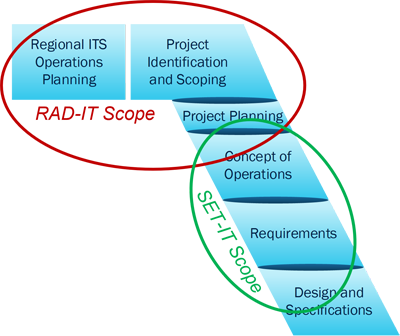Use in Project Development
The regional ITS architecture provides context for ITS projects. By using the regional ITS architecture as a starting point, the steps taken by each project will be on the path to the larger objectives set forth in the long range transportation plan. The ARC-IT tools, RAD-IT and SET-IT, allow the transportation planner and project developer to use ARC-IT to create their own regional ITS architecture and project architectures, respectively. These tailored architectures are not just references: they are structured descriptions of services provided, relationships required, and items to be deployed, operated, maintained and managed. As responsibility shifts from the planner to the project developer, ARC-IT tool use shifts from RAD-IT to SET-IT.
Architecture and Standard Use
A well-maintained regional architecture can provide a tool for making a strong initial start in doing the systems engineering for a project. Regional ITS architecture content such as the stakeholders, their roles and responsibilities (included in the operational concept), elements, service packages, and the list of agreements supports the project concept of operations. The functional requirements are high-level requirements that can support system requirements development, and the interfaces and ITS standards support project design. In addition to assisting project implementers in the preliminary engineering stage, planners may also benefit from participating in the conceptual development of projects and strategies prior to the start of the formal project development. These components can inform creation of project documents, including Requests for Proposals (RFPs), and architectural details can inform the project's scope of work.The items from the regional ITS architecture that are used to jumpstart the systems engineering process are derived from ARC-IT using the Regional Architecture Development tool for Intelligent Transportation (RAD-IT), formerly known as Turbo Architecture. The physical objects used to define the inventory elements, functional objects and functional requirements, information flows used to define the interfaces, and related ITS standards are all derived from the ARC-IT definition. More information on how the regional ITS architecture can be used to start to support systems engineering is included in the the FHWA Systems Engineering for ITS website at https://ops.fhwa.dot.gov/seits/.
However, the information contained in a Regional ITS Architecture can provide only limited support for the Design steps of the systems engineering process because the Regional ITS Architecture is fairly high level in its description of ITS systems and projects. A new tool, the Systems Engineering Tool for Intelligent Transportation (SET-IT), has been developed to support a more detailed definition of a project architecture. This more detailed representation can be used to provide additional inputs to the systems engineering development process. This tool provides graphical depictions of Physical, Enterprise, and Communication views which are tied to an underlying database of information as well as to information from the Regional ITS Architecture. SET-IT supports the additional level of detail appropriate for project development efforts SET-IT can also be used to create a Concept of Operations using a standard outline template and data from the project architecture, including Needs, Stakeholder Roles and Responsibilities, user scenarios, and a high-level view of the architecture. Other SET-IT outputs support subsequent systems engineering documents, in particular requirements documents and high level design (architecture) documents. Relevant outputs include Requirements tables, detailed diagrams, service package use scenarios, security classifications of flows and objects, and Communications Profile diagrams.